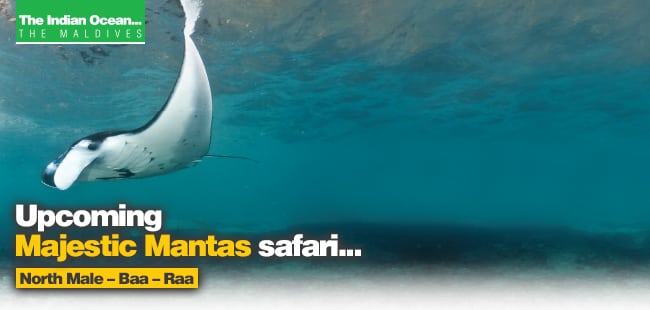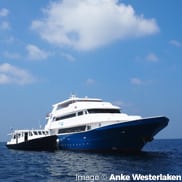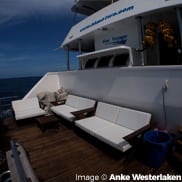Start your Maldives diving adventure today…


Itinerary:
THE BEST OF THE MALDIVES
Dates: 20th Jan 2024 – 27th Jan 2024
Aboard: M/V EMPEROR VOYAGER
The Vessel…
M/V Emperor Voyager sails from Male and is a modern, spacious liveaboard built to a high standard, accommodating a maximum of 20 guests per trip.
There are 10 cabins for guests. Two twin bed cabins on the upper deck, 1 twin bed cabin on the main deck, 3 double bed cabins on the lower front deck and 4 twin bed cabins on the lower deck. All twin bed cabins have beds side by side. All cabins offer en-suite facilities, air conditioning and a fan. The main deck has a large outdoor dining table and a corner bar and drinks area. There are several tables inside for relaxing. On the upper deck is a home theatre and comfy sofas, whilst outside is the VIP lounge with sofas and chairs facing the sea where relaxation and aperitifs are the order of the day.
The sundeck is perfect for catching those sunrays and taking a nap in hammocks or deckchairs. There is a photography charging station on board but all diving is done from her large dhoni tender, giving you more living space on board.
FREE Nitrox as standard.

Itinerary Highlights…
South Male Atoll: The six big channels, or kandus, here are not known for coral, but they have amazing pelagic life, big schools of fish, and tons of sharks. Cocoa Thila is one of the most famous South Male dive sites. If you’ve got the perfect amount of current, you can see rays and all the rest; luckily, there are some dips and caverns in the topography in which divers can rest as they watch the goings-on. Cocoa Thila is a big pinnacle rooted in deep, deep water, and it’s located on the perimeter of South Male Atoll, this means you may well be doing a drift dive in the same current that brings in the big ocean life. Guraidhoo Kandu South is a large area hosting varied topography warranting several dives. Here, divers can submerge on a vertical or horizontal plane, from walls, to flats, to channels, to caves. Sharks glide along the waterways while tons of different reef denizens enjoy their holes and hiding places. However, for bucket loads of sharks, Embudhoo Kandu comes top of the list with it’s healthy population of white tip and grey reef sharks. Kandooma Thila is another prime site, located in the thin channel alongside this thila an intense current brings a crazy amount of activity, including schools of barracuda and other big predators. Other sites include Vadhoo Caves and Kuda Giri Wreck. At Vadhoo , one cave after another offers the chance to chill with reef inhabitants among a garden of colorful soft corals, while watching sharks glide by in the adjacent open water. At Kuda Giri Wreck, inexperienced divers have a great chance to jump in the water to explore the artificial reef and its inhabitants with little or no current.
North Male Atoll: There are dive sites here to suite all tastes and abilities. Manta Point may be the most famous, get ready to see more mantas than you can keep track of, as well as sharks and other reef residents. Another top location is Girifushi Thila, the current here is full-on, so expect a drift dive alongside scenery of colorful soft corals and water full of fish, including rays, sharks, and tuna. One of the best-loved and first-discovered is Banana Reef, which still showcases healthy thickets of branching corals. Along the curve of this banana-shaped reef, giant grouper and morays can be found. A huge school of bannerfish hangs in the current at the edge, and a few incredible caverns call for investigation. In another area, the impressive 100 meter Maldives Victory Wreck, has enjoyed over thirty years of colonization by creatures of the sea. The current can be strong but once you find in sheltered areas you can enjoy the big and small fish and invertebrates that have made this wreck their home. More sharks are available at Miyaru Faru, where divers watch the blue-water show from the safety of an overhang on the wall. The incoming current brings crystal-clear water and pelagics, including manta rays, eagle rays, tuna, and more. Two stunning sites for less experienced divers are Hans Haas Place with plenty of overhangs and small caves, and Back Faru, which offers good reef and pelagic life in incredibly low-stress conditions.
Ari Atoll: Within Ari Atoll’s 40 km length and 105 small islands, site after site vies for divers’ attention. it is the most reliable Maldives location for whale sharks and manta rays, as well as for tons of reef sharks and turtles. The area’s general topography is dominated by kandus and thilas. Ari’s main draw is the large wildlife in the water column and various marine protected areas ensure the conservation of its incredible underwater creatures. Maaya Thila is considered one of the top Maldives dive sites for both day and night dives. This pinnacle is famous for the wild abundance and diversity of its reef life, from nudibranchs and octopus to schools of pelagic fish. Maaya’s neighbor Donkalo Thila holds its own crown as a premier cleaning station for mantas and sharks in the western section of the atoll. Kudarah Thila and Rangali Madivaru, both in the southern section host high-volume manta cleaning stations as well, while Ukulhas Thila is the premier manta cleaning station in the north. Hammerhead Point in Rasdhoo Atoll, northeast of Ari, tops it all off. The deep water drop-off near this site gives divers a special opportunity to see hammerheads, the highlight for many divers. Fish Head pinnacle is the best place for an adrenalin pumping dive- here, throngs of bustling grey and white tip reef sharks scour the reef for their dinner under huge schools of dancing fusilier. Maamgili, where plankton-rich waters nourish whale sharks gliding over wrecks that also host large marble rays and nurse sharks. For wrecks Fesdu Wreck in the north is popular with macro critter lovers for it’s resident ghost pipefish and plethora of nudibranchs and flatworms. The fishing trawler was sunk to become an artificial reef more than ten years ago, Halaveli is a 33 meter long freighter where huge blotched fantail rays provide an impressive counterpoint to the macro-life tucked into the wreck’s holes and corners, and can be dived day or night. Rahdhigga Thila is crowned in its shallows with healthy branching corals and festooned on its sides with soft corals in every shade of the rainbow, not to mention other benthic organisms like sponges of many shapes and sizes. Pelagics lovers won’t even feel left out here because Rahdhigga hosts shark action from silver tips, white tips and grey reef sharks. At Omadhoo Thila the dive sites lies in the Omadhoo channel where two thilas meet, to give it the nickname of the “Big Valley”. The thilas large coral blocks form an interesting landscape. with numerous overhangs along the reef where there are many colourful hard and soft corals, as well as the infamous long-nose hawkfish hiding in the black corals. Looking out into the blue, divers can often see napoleon wrasse, barracuda, eagle rays and white tip reef sharks. Large schools of bannerfish, snappers and fusiliers are found swarming above the reef top. Omadhoo is widely regarded as one of the true highlights of South Ari Atoll. Kuda Giri is a small reef that starts at just 3 metres which has overhangs running around the coral block between 12 and 22 metres, before levelling out at 30 metres into a sandy plateau. The reef is covered in disc anemones and black coral trees, overhangs are home to lobsters, moray eels and lion fish. In the blue water, keep an eye out for schooling fusiliers and bannerfish.
Felidhoo (Vaavu) Atoll: In the waters around Felidhoo’s relatively undeveloped 19 islands, deep, fast-flowing channels promise abundant sharks and big pelagics like manta rays. At this easternmost area of the country, the Fotteyo barrier reef stretches for 50 kilometers along the open ocean, offering plenty of opportunities to see large marine life. While kandus (channels from the open ocean into an atoll) and thilas (pinnacles, or sea-mounts) characterize Maldives diving throughout the archipelago, Felidhoo boasts one of the best kandu scenes in the country. Besides kandu diving, Felidhoo also offers a fantastic night diving. Fotteyo Kandu is considered one of the Maldives’ top sites, within this narrow channel, reef sharks and plenty of fish can be expected, including big groupers, and (if youíre very lucky) hammerheads. There are plenty of overhangs and swim-throughs, which add variety to the dive and give photographers plenty of opportunities. Miyaru Kandu, is another diving highlight with schools of grey reef and whitetip reef sharks, as well as a variety of other big pelagic and reef fish. Overhangs, small caves, and hard and soft corals diversify the channelís topography. Miyaru is known as a good site for mantas, and in general, the entire Felidhoo Atoll provides good manta sightings, especially between May and July. At Alimathaa Island, two kandus named Devana and Dhekunu offer the chance to see pelagic rays in the blue water, as well as sharks, tuna, and big schools of reef fish. The current in these channels can be very strong. For a slower-paced, but no less thrilling experience, Alimathaa Jetty provides the opportunity for a night dive with nurse sharks and stingrays.
£3095 per person ( Inside Cabin)
Includes: Return flights from Manchester* – Male, internal transfers, full board on the vessel (incl. water, tea/coffee), all diving on 12lt cylinder with air fills and weights, and Green tax.
BOOK NOW!
Please contact Mark or Paul at Aqualogistics on 01614805745 or email geoff@aqualogistics.co.uk for more information or to book on this fabulous Maldives safari!

